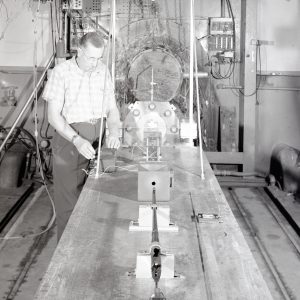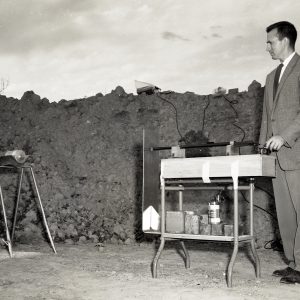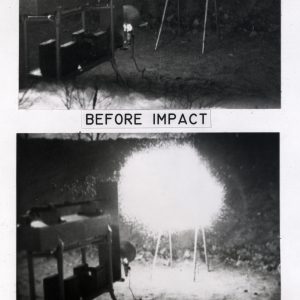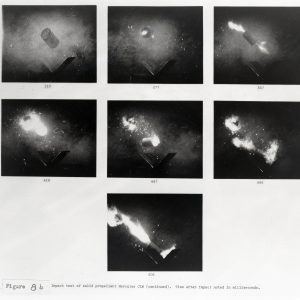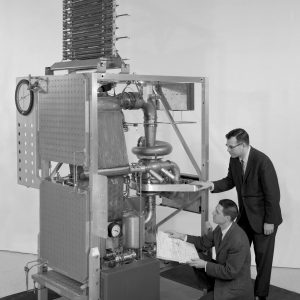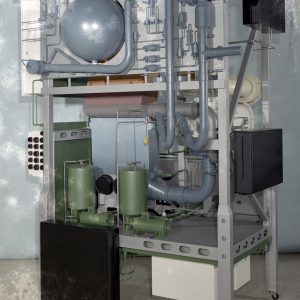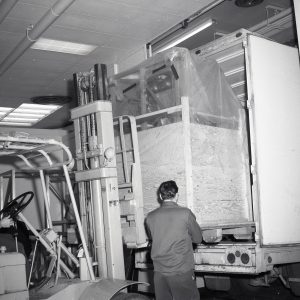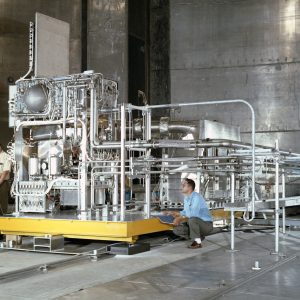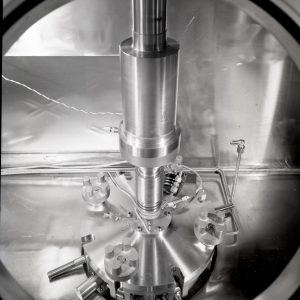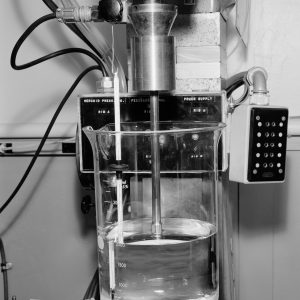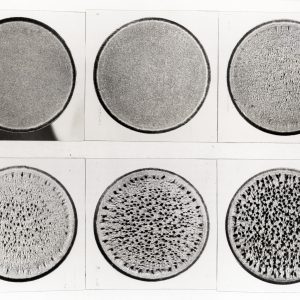Space Activities
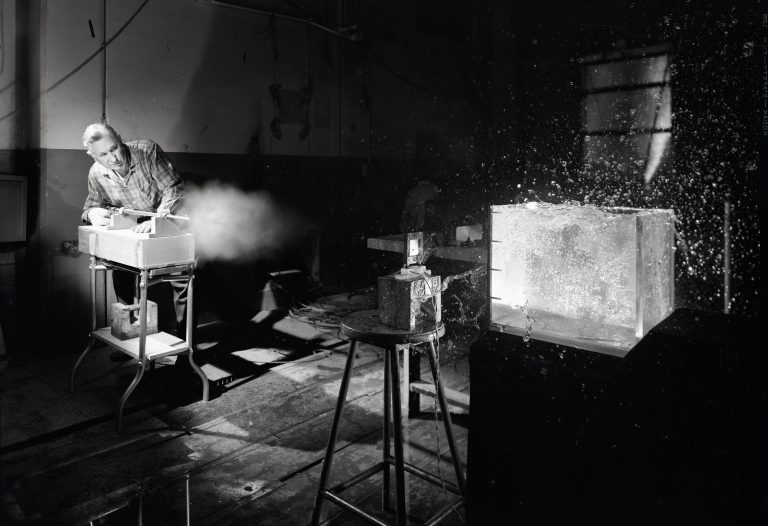
In the 1960s, researchers used the Special Projects Laboratory (SPL) to test cryogenic insulation, materials for solid rocket nozzle inserts, technologies for nuclear-electric systems, and other space-related projects.
Overview
On October 4, 1957, the Soviet Union launched Sputnik into orbit and instantly sparked the Space Race. The United States spent the next six months trying to determine how to adjust to the perceived deficit in missile and space technology. By April 1958, President Dwight Eisenhower decided to build a civilian space agency that incorporated the existing National Advisory Committee for Aeronautics (NACA) laboratories with missile teams from the Jet Propulsion Laboratory, Redstone Arsenal and National Science Foundation. On October 1, 1958, the National Aeronautics and Space Administration (NASA) began operations.
The Cleveland, Ohio laboratory, renamed the Lewis Research Center, quickly reorganized its staff to focus on space activities. The center began increasing its workforce and constructing new facilities to meet the new challenges. During this period, several aeronautical facilities were modified for space work, including the Jet Propulsion Static Laboratory (JPSL). The engine rigs were removed from several of the test cells, the spin pits were shut down and the several of the shop rooms were converted into test areas. In 1961, the facility was renamed the Special Projects Laboratory (SPL) to reflect this change. Researchers used the SPL to test cryogenic insulation, materials for solid rocket nozzle inserts, high-temperature liquid metals for nuclear-electric systems, gamma radiation shielding, liquid-metal heat exchangers and liquid hydrogen microgravity drop tests.
Document
Tank Impact Studies
Micrometeorites posed a serious concern for NASA engineers during the early years of the space program. There was insufficient data to determine the risk these tiny high-speed objects posed to spacecraft. Researchers expended a good deal of effort during this period analyzing damage space debris could cause and developing strategies to shield space hardware. Propellant tanks for upper-stage vehicles were a particular worry because of their size and the reactiveness of the fuel. In addition, in space, a pocket of gas tends to form in the center of the liquid, which increases that tank’s internal pressure and susceptibility to stresses. NASA Lewis formed a Structures Branch to address these issues. Their research included impact testing and the launching of experimental meteoroid-detecting satellites.
A series of tests were conducted in the SPL during the mid-1960s to study the effect of high-speed impact on liquid-filled tanks. Researchers began by using a table-mounted .22 caliber rifle to fire various projectiles at thin test specimens affixed to the end of cylindrical tanks filled with water, glycerin or liquid nitrogen. During follow-up tests at an outdoor facility, they again used the rifle to shoot various projectiles at different cylindrical tanks that were filled with liquid oxygen or rocket fuels. The investigators then used a light gas gun in Cell 2 of the SPL to significantly increase the velocity of the projectiles. The device used highly compressed hot hydrogen to accelerate the projectiles into the test specimens that were affixed to metallic tanks.
Although the researchers were not able to develop a single predictive calculation to account for all of the different variables associated with the projectile, the tank and liquid, the SPL investigations provided a variety of data to be applied to tank design. The initial tests demonstrated that the projectiles could generate sufficient pressure waves in the liquid to cause catastrophic ruptures of the tank walls. The high-speed impacts fractured the liquid-filled tanks but penetrated the gas-filled tanks without causing catastrophic failure. For failure to occur, the speed of the projectile must be considerably higher than the speed required to penetrate the tank wall. They found that titanium tanks reacted violently to any penetration, but stainless steel, aluminum and plastic tanks did not respond to the breach. They also noted that smaller high-speed objects caused more damage than larger low-speed projectiles.
NASA engineers were able to understand and protect against space debris in the agency’s initial space exploration. The issue, however, remains a concern today due to the large number of man-made objects and debris now orbiting earth. NASA’s White Sands Test Facility has a number of facilities that simulate the hypervelocity impact of debris on space hardware.
Documents
- Space Debris Hazard Evaluation (1961)
- Catastrophic Fracturing of Tanks when Impacted by Projectiles (1964)
- Investigation of Pressure Waves Generated by High-Velocity Projectiles (1965)
- Projectile Size and Material Effect on Impact Fracture of Tanks (1966)
- Meteoroid Damage Assessment (1970)
Brayton Cycle Hardware Assembly
In the mid-1960s, Lewis began exploring various methods of generating power for long-duration space missions. These included solar, nuclear-thermal and liquid-metal systems such as the Brayton Cycle. The Brayton Cycle is a closed-loop system that heats an inert gas. The expanding gas rotates a turbine that drives the compressor and electrical generator. The gas is then cooled by a radiator and recycled. There are no byproducts or exhaust. There were a variety of options for the heat source, including solar and nuclear. Lewis researchers developed their own version of the Brayton Cycle in the 1960s.
In January 1969, members of the Space Power Systems Division used an SPL shop area to assemble the Brayton system’s Brayton Rotating Units (BRUs) with a heat exchanger. They then operated this unit for 500 hours in another facility to verify its performance. This was followed by the successful test of the complete Brayton system, including its space radiator, in a massive vacuum chamber that simulated the conditions of space. The center has continued to study Brayton Cycle technology over the years, including additional component tests lasting up to 21,000 hours, the possible use of Brayton solar-dynamic systems for the space station in the 1980s and 1990s and nuclear-heated Brayton systems in the 2000s for the proposed Jupiter Icy Moons Orbiter.
Documents
- Historical Review of Brayton and Stirling Power Conversion Technologies (2007)
- Performance Characteristics of Three Brayton Rotating Units (1970)
- Performance of a Brayton Power System with Radiator in SPF (1974)
Liquid Hydrogen Cavitation
Lewis researchers began an extensive study of cavitation in the early 1960s while developing turbopumps for cryogenic rocket propellants. Cavitation is the formation of bursting bubbles in a moving liquid as temperature rises or pressure decreases. Cavitation can hinder performance and physically damage hardware over time. Lewis initiated an extensive effort to study liquid hydrogen cavitation for its high-energy propellants program. In the mid-1960s, Lewis began studying the effects of cavitation in liquid metals that served as the working fluid in advanced space power systems. The physical damage component was a particular concern for space power systems, which must operate for long periods of time.
Lewis researchers designed different methods to accelerate the study of the accumulative effect of cavitation on different materials. One such tool was a magnetostrictive apparatus, installed in Room 116 of the SPL, that employed a magnetic system to introduce high-frequency vibrations into fluid. The rig provided researchers with an economical method of studying the resistance of various materials to cavitation in different liquid metals. The apparatus consisted of a vacuum dry box with glove ports that contained a magnetostrictive transducer, which vibrated the test articles soaked in liquid metal inside a vacuum-sealed test chamber. A resistance furnace heated the specimen. The cleaned test articles were subjected to cavitation damage by vibration for varying intervals. After each run, the articles were removed, measured and examined for surface damage. Researchers recorded the loss of volume, the rate of loss and surface roughness.
Initial studies in 1966 analyzed damage to iron, nickel and cobalt alloys in liquid mercury and sodium cavitation and compared it to tests conducted with full-scale pumping systems. Follow-up tests of a cobalt alloy revealed that pressure was a greater cause of cavitation than temperature. The tests were then expanded to include a variety of other materials, which were then ranked according to the volume loss, rate of loss and surface roughness.
In an effort to create uniform vibrational data, the American Society for Testing and Materials (ASTM) initiated a study in 1967 to compare vibratory test facilities available at different laboratories. Lewis staff contributed to this study by testing two materials in the SPL magnetostrictive apparatus. The result was a standardization of test conditions from the different facilities. Lewis researchers also used the SPL’s magnetostrictive apparatus to study the effects of vibration on the hardening of materials. They subjected several steels and superalloys to 25,000 hertz vibration while submerged in an age-hardening heat-treating bath for six hours.
Documents
- Accelerated Cavitation Damage in Liquid Metals (1966)
- Effect of Temperature and Pressure on Cavitation Damage of Cobalt (1969)
- NASA Research on Resistance of Materials to Cavitation Damage in Liquid Metal (1970)
- Cavitation Test for ASTM Round Robin Tests (1968)
- Effect of Ultrasonic Vibration on Hardening of Steels and Superalloys (1969)
Images:

